Essentials of Energy Benchmarking on Multi-Family Properties

Since 2019, more than 3,000 sustainability-related disclosures, regulations, and policy instruments have been developed worldwide to reduce carbon emissions, improve energy efficiency, manage water resources, mitigate greenhouse gas (GHG) emissions, and improve air quality in real estate assets. The global movement to address these issues through environmental, social, and governance (ESG) initiatives reflects societies’ elevated expectations of governments and organizations to help manage natural resources and improve local communities. In turn, Investors have become increasingly socially and environmentally conscious, as demand for corporate transparency, disclosure, and accountability has risen.
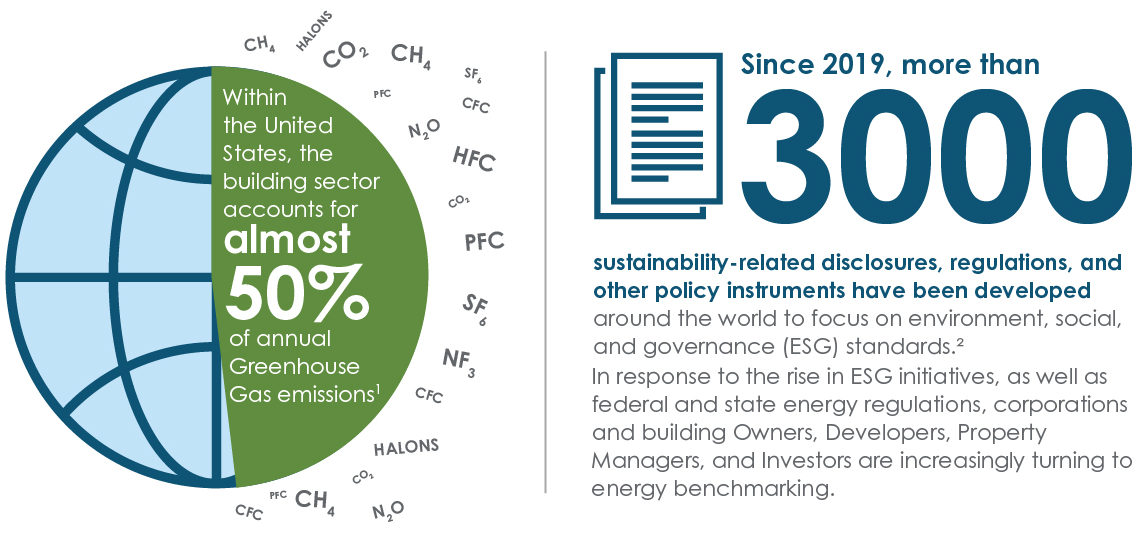
The real estate industry is experiencing the impact of those initiatives, especially environmental criteria that address how a company performs as a steward of the natural world. With climate change now widely accepted as financial risk, creating resilient real estate assets means using green and sustainability strategies in both new and existing buildings. Such strategies are implemented to mitigate the growing threats to real assets, such as rising sea levels, forest fires, and floods.
Environmental issues to be addressed in real estate can include climate change, wildlife habitat, energy demand, energy consumption, and GHG emissions, in addition to indoor environmental quality, renewable energy, sustainable procurement of materials, waste management, and water resource management and consumption. One of the highest-impact areas in real estate is energy consumption. The construction, real estate, and built environments currently account for almost 50% of all GHG emissions in the United States. There are a variety of ways to reduce a building’s overall energy consumption and carbon footprint; no matter which strategy you choose, tracking and reporting the building’s energy consumption is critical.
In response to the rise in ESG initiatives, as well as federal, state, and city energy regulations, corporations and building Owners, Developers, Property Managers, and Investors are increasingly turning to energy benchmarking. Evaluating one building’s energy performance against another building using energy benchmarking allows Owners, Operators, and other stakeholders to compare different properties within regions to optimize portfolio performance. As the physicist William Thompson once said, “If you cannot measure it, you cannot improve it.”
Energy benchmarking for multi-family construction is now required in a growing number of jurisdictions and financing institutions. The building’s energy consumption data is real-world operating conditions to compare simulated energy modeling results, as well as provide a baseline for mandatory energy consumption scoring and reporting. Sharing building energy performance information promotes transparency and accountability. Making benchmarking data available to all stakeholders, including tenants, allows for the evaluation of common energy goals by identifying and rewarding conservation and efficiency.
The data gathered from benchmarking on multi-family properties is a method to document current energy performance, provide a foundation to set and achieve efficiency goals, target inefficiencies for strategic retrofits and capital improvements, reduce energy consumption costs, and more. With energy benchmarking, multi-family Owners, Developers, Investors, and Operation and Maintenance (O&M) personnel can identify and prioritize future building improvements, improve occupancy rates, and even advertise your building’s performance, as well as differentiate and monitor your building’s performance compared with your marketplace.
The Facts About Energy Benchmarking

Metering is required by utility companies, but the approach can differ depending on the utility provider and building type. Energy management on new and existing multi-family properties with submetering of individual dwellings provides granular detail of individual dwelling units.
Submeters are installed after the master utility meter; they’re often used on properties that already have a master meter, but the Owner has chosen to split energy usage according to each tenant’s actual consumption. Owners and O&M personnel may be responsible for paying utility costs on properties with only master meters; this, however, does not allow tenants to verify their actual usage. Not having that verification may result in paying more for less energy consumption and tenants being disincentivized to decrease their energy use. By using submeters for each dwelling unit, tenants can learn the amount of energy they consume. They can also be billed accordingly, instead of using the older, less reliable method of area-based calculations.
Where individual utility meters are used, utility companies are often not required to provide whole-building energy consumption data. Projects built using the 2006 IECC or later energy code are required to separately meter electricity for individual dwelling units to allow tenants to see and review actual energy consumption. However, experienced sustainability consultants can ensure that energy consumption data is properly obtained, accurately interpreted, and reported correctly for benchmarking.
Energy benchmarking is the process of taking billed energy usage and compiling the results into a database in order to compare the building’s energy use against similar structures in the same sector and region. This data gathering and comparison gives Owners, Developers, and Operations personnel detailed insight into how their assets are performing, in terms of energy efficiency, compared to other buildings.
Benchmarking provides insight into areas where efficiency can be improved and helps set baselines for building energy performance standards. The information obtained during the benchmarking process allows for better management of buildings’ energy consumption, driving energy-efficiency measures. This often results in financial savings and helps achieve environmental and health benefits, such as lower GHG emissions and improved indoor air quality.
Benchmarking has been common in the commercial and industrial building market, though it is relatively new in the multi-family industry, having been added in 2014. Benchmarking enables Owners, property managers, and tenants to identify, analyze, and gain insight into trends in a building’s energy use and waste. The data helps to identify buildings that exceed energy use metrics and adjust the operations or identify capital improvement projects for those buildings. Owners can experience significant savings from greater insight into, and management of their buildings’ energy consumption.
Benchmarking data can also be used by building operations personnel, asset managers, and Owners to help them determine and prioritize retrofits, attract tenants, and more. By scoring your building against other like-buildings outside of an Owner’s and asset manager’s portfolio, you can determine how your property compares against others and evaluate which properties are most and least efficient.
Commercial building managers can review energy bills, as well as energy usage data, from utility companies to evaluate their greenhouse gas emissions and determine efficiency upgrades, as sustainable technologies and appliances are increasingly important to today’s tenants. Millennials often choose to practice sustainability personally and professionally, more so than previous generations. In a 20% increase from older age groups, 81% of Millennials believe that developing and using alternative energy sources should be prioritized nationwide. Further, over half of all US adults now agree that businesses should increase their efforts to help mitigate climate change; as a result, business leaders, especially those from the Millennial generation, are vouching for green building programs and operating their companies more sustainably.
Accessing energy data for multi-family buildings is more challenging, due to how the over-building is metered with the dwelling units each having individual utility meters, tenant turnover, and the tenants’ responsibility to pay energy bills directly. Before conducting renovations, energy consumption analysis enables property owners to identify which projects will have the greatest impact on energy efficiency and fastest rate of return; equipment and systems that have a greater impact on energy can be prioritized over those that have less impact on energy and power demand.
The ENERGY STAR Portfolio Manager (ESPM) is a free nationwide database that compares and scores buildings based on energy usage information from Owners, Developers, environmental regulators, and sustainability consultants. Working with third-party experts, like those from Jordan & Skala Engineers, helps Owners and O&M personnel ensure that benchmark reporting is done accurately with ENERGY STAR.
Benchmarking with the ENERGY STAR Portfolio Manager can be a time-consuming, meticulous process on multi-family properties with meters for each dwelling unit, versus an entire commercial building with as few as one utility meter. When individual dwellings are metered, the utility company’s Customer of Record is the tenant; the tenant is required to give authorization for a third party to collect and input the data into the ENERGY STAR Portfolio Manager, creating a level of complexity beyond a commercial or industrial building.
Gathering and submitting energy data to ESPM requires an organizational process that demands both in-depth technical knowledge and a thorough understanding of local regulations. Unless Owners or O&M personnel work with a knowledgeable third-party professional, they must properly collect the data for each unit, register it with the systems, and track it themselves. With qualified professionals and accurate reporting to ESPM, multi-family Owners and Developers can see savings from benchmarking efforts directly.
Benchmarking with ENERGY STAR Portfolio Manager

ENERGY STAR Portfolio Manager (ESPM) is a free tool that lets you track and document improvements to an individual property’s energy efficiency rating with one of the largest listings of buildings for comparison. It uses an Owner’s survey to compare buildings’ energy performance.
After a sustainability consultant or an Owner inputs a building’s data, it is organized and uploaded into the tracking software. The resulting comparisons and analysis help identify, analyze, and interpret trends or patterns in a building’s utility data. Reports can be pulled monthly for updated energy/water scores that encompass data from the most recent 12 months.
ENERGY STAR also provides a form, Statements of Energy Performance (SEP), which is the most widely used tool to acknowledge that benchmark energy consumption has been input accurately. To obtain the information needed for the form, a Professional Engineer, such as a licensed expert from Jordan & Skala Engineers, is required to verify that information is correct and true, which may include a site visit.
The Benefits of Energy Benchmarking
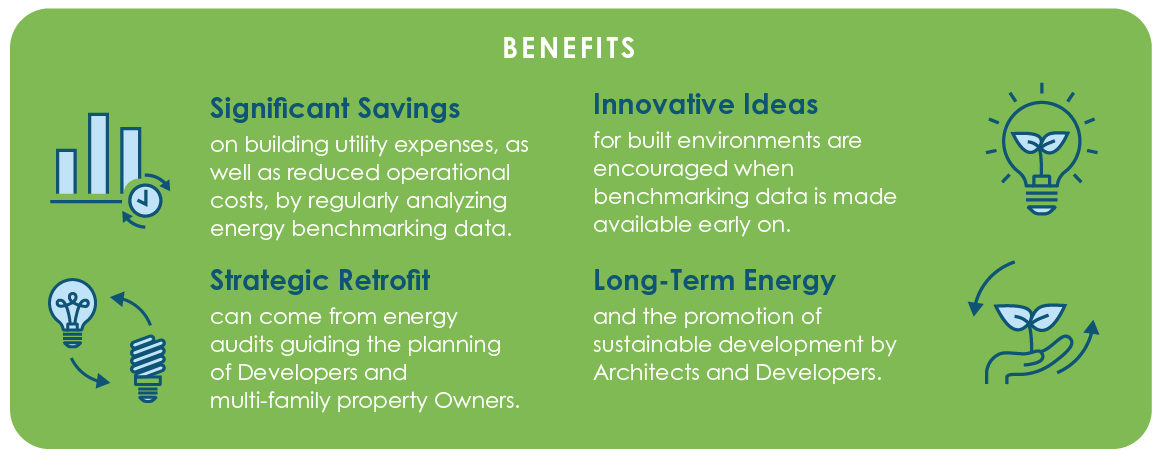
Considerations for Developers, Owners, and O&M
Tenants on multi-family properties remain residents longer when their utilities are affordable and operational maintenance costs are reduced; by regularly analyzing a building’s energy performance, Owners can increase their property’s affordability and enjoy higher tenant retention rates. Energy data can be collected, monitored, and analyzed to determine capital improvements for buildings and as a portfolio tool for property management to sell or improve specific properties.
Owners and O&M personnel can leverage energy benchmarking results to compare buildings in their portfolio and understand how property/portfolio energy and water performance changes over time. Benchmarking helps increase transparency, property values, meet local policies and mandates, secure Green Loans, as well as attract both Investors and new residents.
Benchmarking Prep: Predicting Performance
Energy models can be conducted prior to a building’s construction to create projections for the project’s likely energy consumption. These models allow sustainability consultants to calculate a project’s likely energy consumption from design drawings and energy model standards in order to provide an estimated ENERGY STAR (ES) Score for the project; that score, in turn, indicates how the building’s energy benchmarking results will likely perform in the ESPM when in operation after construction or renovation.
The Design ENERGY STAR Score is the Statement of Energy Design Intent (SEDI) and is used to apply for green financing options and for certification under the Designed to Earn the ENERGY STAR standards; therefore, the process should begin early in the conceptual design or design development phase of the project. Benchmarking, however, occurs once a building is in operation; therefore, energy benchmarking data is not available to project partners during design and construction unless a similar building is used.
Post-Benchmarking
An energy audit conducted by an experienced sustainability consultant, like those at Jordan & Skala Engineers, can guide multi-family Developers and Owners toward strategic improvements. Third-party experts use energy benchmarking and on-site analysis to recommend property improvements that promote efficiency, increase utility savings, and identify wasteful equipment. These professionals accurately collect, track, and report energy-using equipment and data, which relieves O&M personnel of highly technical responsibilities that impact a building’s energy score.
Developers and Owners can enjoy greater peace of mind, save time, and eliminate the need to track data, with licensed, qualified consultants who understand building systems and functionality.
Considerations for Architects and Engineers
Design professionals can use energy benchmarking data to better understand what is and isn’t working in a building, resulting in new construction and retrofits that promote sustainable developments, as well as long-term energy savings. Benchmarking information is not typically provided to project partners during the design and construction periods. The energy benchmarking process is completed after a building is already operational to reflect the building’s real-world energy consumption.
Prioritizing energy efficiency and benchmarking from a project’s onset helps ensure a strong baseline that achieves code compliance and can earn financial incentives for new construction. Incorporating energy conservation designs or improvements based on benchmark reporting assists Owners and property managers towards competitive energy consumption scores, meeting energy ordinances, and earning recognition for different green building programs, including NGBS and LEED certification. This attracts potential tenants and stakeholders by appealing to those with a stronger interest in sustainability and environment, social, and governance (ESG) initiatives.
Energy targets based on existing datasets, such as EIA Commercial Energy Consumption Survey 2018, ENERGY STAR Portfolio Manager (ESPM), ASHRAE 90.1-Appendix G, or your own design portfolio, should be established from a project’s onset to help determine appropriate performance targets and metrics to measure the building’s actual energy use when operating. Project partners can use energy consumption and comparison data while collaborating with Owners and Developers to identify appropriate systems or retrofits that achieve building energy efficiency goals.
Energy Benchmarking in Multi-Family
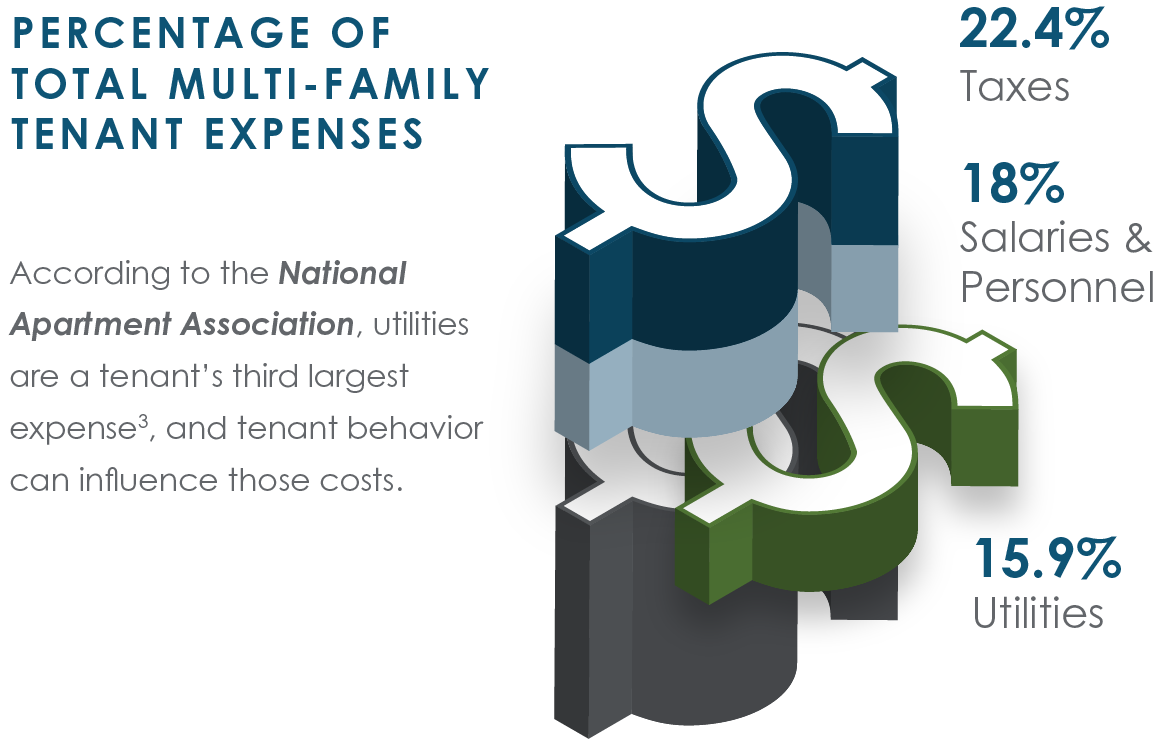
Financing institutions can now require energy benchmarking data from an Owner in order to consider them for certain preferential financing or multi-family loans.
To qualify for Fannie Mae’s Green Rewards, loan applicants must provide benchmarking results. Freddie Mac’s updated requirements for Green Up® and Green Up Plus® loans include borrowers retaining a qualified third-party Benchmarking Data Consultant, like Jordan & Skala Engineers, to perform an energy audit, collect, input, and monitor actual energy and water usage on multi-family properties before the loan originates. Green Consultants must provide a Green Assessment®, which includes an analysis of how they can save energy or water by making improvements. This is known as an ASHRAE Level 2 Energy Audit.
HUD financing uses energy benchmarking data to determine eligibility for significant reductions to a project’s mortgage insurance premium (MIP). HUD 221(d)4 is a newer, innovative MIP reduction program for new market-rate multi-family construction projects. HUD 223(f) provides similar incentives for energy improvement renovations. Program requirements include energy modeling, a Statement of Energy Design Intent (SEDI) score, as well as an approved Green Building Certification, such as the National Green Building Standard (NGBS), LEED, or Enterprise Green Communities.
To qualify as an ENERGY STAR Certified Building and for HUD 221(d)4 financing, you need utility benchmarking (including resident utility consumption) ENERGY STAR score, or Statement of Energy Performance (SEP), of at least 75. This score indicates that a building is performing in the top 25% of similar buildings in its sector. Ways to boost your building’s score include:
- Creating a Capital Improvement Plan to examine Envelope and MEP systems, such as air barrier, light fixtures, appliances, and HVAC systems;
- Implementing equipment upgrades;
- Investing in on-site renewable resources, which can reduce energy usage pulled from utility companies; and
- Working with licensed experts, like those at Jordan & Skala Engineers, to conduct an ASHRAE Energy Audit.
ASHRAE defines three levels of Energy Audits: Levels 1, 2, and 3. Each level increases in complexity and has its use in the built environment.
During a level one audit, the sustainability consultant performs a one-day walkthrough of building systems to evaluate the age, functionality, and efficiency of the building. The consultant may analyze energy bills, identify low- or no-cost efficiency options, and make recommendations for further investigation. In addition, this audit fulfills the first prerequisite for LEED O&M EA: Energy Efficiency Best Management Practices — Planning, Documentation, and Opportunity Assessment.
A level two audit includes the level-one scope, plus more detailed energy calculations for each Energy Conservation Measure (ECM). The consultant might also recommend breaking out each ECM as a separate study to analyze the savings, cost, and payback period for each measure. Recommendations specific to the Owner’s O&M, constraints, and economic criteria may also be included. This earns two points under LEED EB EA credit 2.1: Existing Building Commissioning — Investigation and Analysis Option B. This level of audit is required for the Fannie Mae and Freddie Mac energy-efficient retrofit loans.
The third level of audits involves the sustainability consultant conducting the level-two duties, as well as expanding previous levels of energy calculations or extensive data collection. The report at this level also includes more in-depth cost and savings information to drive data-based decision making, in addition to a timeline for implementation of recommendations for larger capital improvement projects. This level may also look into how different energy improvements interact together.
In the midst of our current affordable housing crisis, one of the factors has been energy affordability, or whether or not someone can afford their utility costs. Energy efficiency contributes to an Owner’s or renter’s ability to afford their home. According to the National Apartment Association, utilities are a tenant’s third largest expense, and tenant behavior can influence those costs greatly.
With energy modeling, experienced sustainability consultants can provide projected energy costs based on a new project’s number of units, specific design, and systems. Benchmarking data provides accurate information about a dwelling’s energy consumption that tenants can use to calculate their potential energy costs. When tenants have insight into their own energy consumption and the right incentive to optimize it, multi-family properties can maximize their efficiency and decrease costs.
Owners, Developers, and O&M personnel face several challenges when attempting to obtain resident utility consumption data. Different housing environments can present different challenges. Energy usage on student housing properties, which are vacant in the summer, for example, may be impacted or mitigated by different tenant behaviors than developments with year-round occupancy, such as senior living or work-force housing developments. High-rise multi-family buildings may also use different types of MEP systems, such as central systems with no direct access to individual dwelling unit meters. Additionally, projects with different energy sources, such as gas, electric, and district chilled water or steam, must account for the buildings’ total consumed energy from all the sources.
Utility companies may not be able to provide individual dwelling unit utility data, due to privacy laws, as residents are often the Customers of Record with providers. To ensure customer privacy while still collecting data needed for building reporting purposes, the utility company can provide aggregate, whole-building data for benchmarking. Utility companies can ensure that all meters and/or consumption-measuring service points can be accurately “rolled up” into a building’s complete energy use. This is generally referred to as “meter-to-building mapping.” However, few, if any, utility data systems are set up to combine individual meter- or account-level data for entire properties; this can burden the data requester, since Owners would be responsible for advising utility companies to update meter-to-building mapping when tenants or meters change.
Owners might not be aware of every meter or service point on their property that tracks energy consumption. Resident turnover can also impact energy usage. Vacant units without smart technology often cannot maintain proper temperatures, leading to energy waste and discomfort for tenants adjacent to the vacant unit. Automated thermostats can be remotely adjusted to keep vacant dwellings at appropriate temperatures, whether a unit is completely empty, being serviced by maintenance personnel, or toured by a prospective tenant.
The sustainability experts at Jordan & Skala Engineers recommend these best practices for Developers and Owners pursuing a return on investment with benchmarking:
- Implement a tenant authorization process so that the utility provider can deliver aggregated energy data without individual authorizations from residents on a monthly basis. Use a low threshold, such as a per-unit energy consumption percentage, that encompasses the greatest number of buildings without risking resident privacy.
- Motivate residents to support efficiency goals by outlining how much greenhouse gas (GHG) emissions have been saved in utility billing and marketing materials, incentivizing residents by offering discounts on rent or prizes, hosting a voluntary competition among residents to see who can save the most energy compared to the previous month or year, or by incorporating smart building technologies. This alone gives residents greater insight into their utility use, preemptively addresses issues like leaks or equipment malfunctions, and minimizes energy waste from unoccupied dwelling units.
- Communicate with sustainability experts to ensure that energy, water, and waste data are updated in ESPM and that ESG Surveys are completed. Since the release of the ESG Disclosure Simplification Act in 2021, many companies will be required to disclose to their stakeholders how their ESG initiatives have impacted their businesses, which often involves energy benchmarking results.
Energy Benchmarking Regulations
A growing number of federal, state, as well as local municipality regulations are requiring energy benchmarking, in order to create more efficient communities that are both environmentally and financially sustainable. The Institute for Market Transformation Building Rating database shows more than 25 state and municipal energy benchmarking ordinances across North America. The City of Arlington, Virginia, for instance, is now requiring all buildings to provide energy benchmarking results. Some cities that utilize benchmarking exempt Owners who cannot obtain whole-building data from their utility provider.
Benchmarking transparency policies can require annual reporting and distribution of building energy data. This information may be available to the public, parties involved in a transaction, or the government, depending on the jurisdiction’s requirements. Aggregate whole-building data allows Owners to better understand and meet local benchmarking requirements while keeping individual tenant energy usage private. Data aggregation is when a building’s energy data is compiled into one place so that it can be analyzed to understand energy use and drive efficiency improvement measures. The process of gathering and organizing that data is typically accomplished through energy benchmarking.
Cities with such policies in place can use the data they gather to create online platforms where Owners can compare their buildings’ energy consumption against local, rather than national, figures. Jurisdictional entities and local governments can also use city benchmarking data to set sustainability goals, conduct more accurate energy modeling, and drive investments in new power production facilities, including renewable resources. Cities can use the information for planning purposes to reduce total energy consumption, creating more sustainable communities. A growing number of jurisdictions, shown below from ENERGY STAR, now mandate energy benchmarking to help achieve sustainability and energy consumption goals.
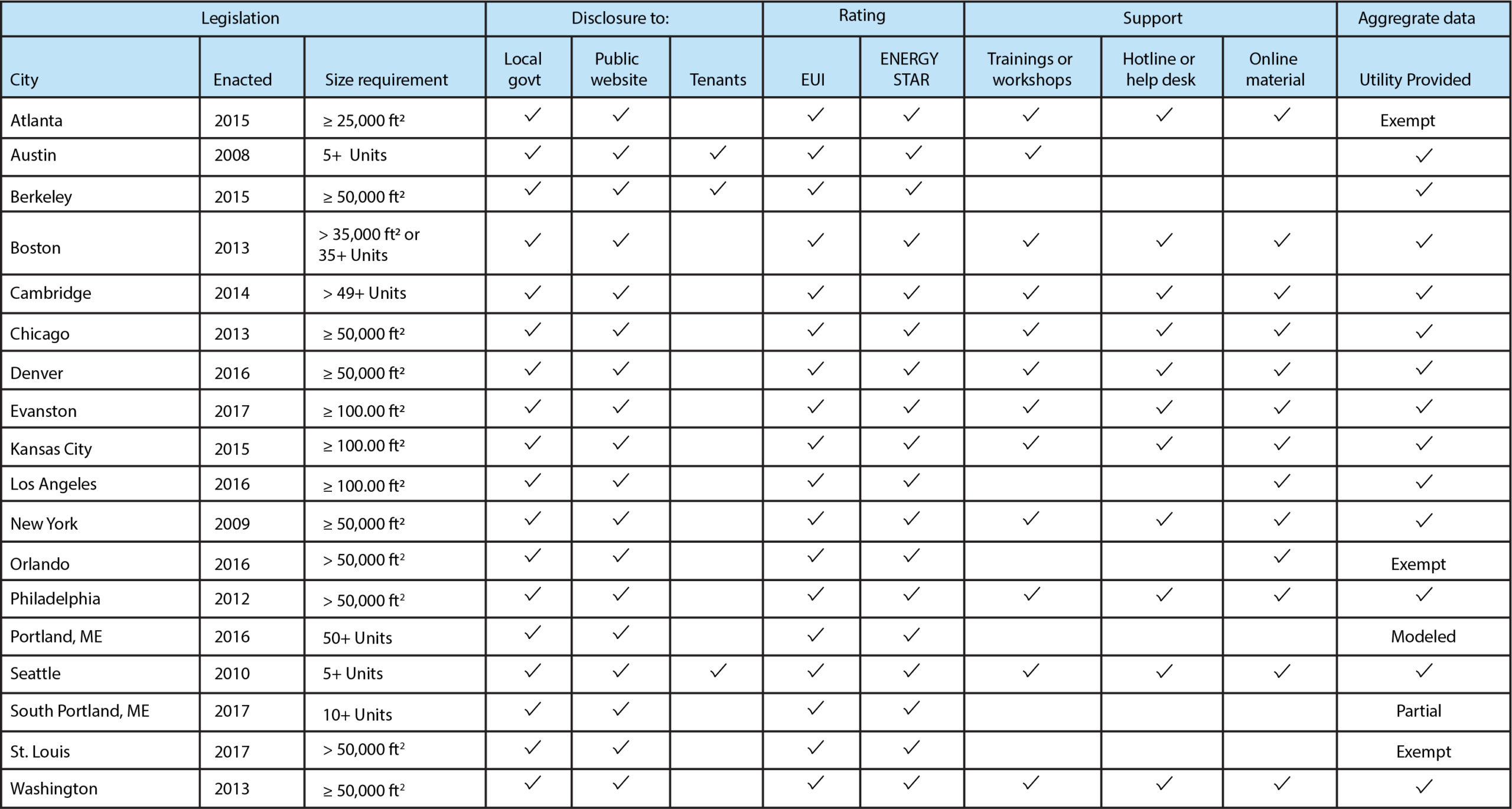
In the “Aggregate data” column above, “Exempt” means that only master-metered buildings must comply. “Partial” means that any available information must be submitted, while “Modeled” requires any available information and allows local governments to determine the values for missing information.
The above table shows that most mandatory multi-family benchmarking initiatives share transparency requirements, create help centers and training for compliance matters, and even include access to aggregate whole-building data from utility companies. Many of these initiatives also include the following major elements:
- Government buildings, which sets a precedent for similar buildings in communities;
- Real estate reporting of environment, social, and governance (ESG) initiatives;
- LEED Building certification and recertification;
- Energy disclosure policies by statewide or regional ordinance;
- Avoiding the HUD, Fannie Mae, and Freddie Mac compliance penalties and the risk of losing ENERGY STAR certifications.
Experts anticipate that mandatory benchmarking will continue and expand, as markets remain concerned about wellness, sustainability, and transparency.
The Impact of COVID-19 on Benchmarking
The pandemic has affected how we all live, work, and interact with our environments. With more people working from home, commercial offices are using less energy, while residential buildings, single-family homes, and apartments are using much more. A significant shift in many tenants’ daily routines will change how buildings are scored with the ESPM benchmarking tools.
ESPM Benchmarking During the COVID-19 Pandemic
The ENERGY STAR score was first introduced in 1999 and has become a popular way to compare buildings of similar type and use. A building’s score is used to compare energy consumption against other buildings in the same sector or marketplace.
In 2014, multi-family housing was added as a sector that could utilize the ENERGY STAR Portfolio Manager; previously, multi-family properties were not included in the ENERGY STAR portfolio because it can be difficult to obtain tenants’ energy data, and it is often an overlooked market sector. Since then, the US Department of Housing and Urban Development (HUD), Frannie Mae, and Freddie Mac financing have incentivized greater involvement from multi-family Owners, Developers, and O&M personnel. Data reporting has also helped increase efficiency and maintain compliance, forcing market transformation with utility company reporting.
The latest available comparison is the 2018 Commercial Building Energy Consumption Survey, which was conducted before the pandemic. This information is expected to be released by Spring of 2022. A more detailed analysis of building characteristic data, which will also include the effect of COVID-19, is scheduled to be released in the Summer of 2022. The data will likely score commercial buildings higher than previous years, due to a decrease in energy usage. Residential buildings, especially those affected by HUD Green Mortgage Insurance Premium (MIP) Reduction incentives, may be negatively impacted by the large portion of the population working and/or learning from home to help mitigate the spread of the virus.
What a Sustainability Engineer can do for You
Sustainability engineers and consultants have the design, operational, and system knowledge, combined with holistic approaches, to reduce both energy consumption and power demand, resulting in lower utility bills with the greatest impact. These experts have the training and experience to ensure quality reporting from start to finish, resulting in accurate energy benchmarking.
Data processing and verification by licensed third-party professionals also helps promote transparency in reporting. Comparing reported footprints with building inventory lists and onsite verification visits can also be done by sustainability professionals. Jordan & Skala’s team are experts in understanding construction documents, architectural plans, MEP drawings and engineering calculations, energy models and predictions, sequences of operations, and more. This holistic approach enables their sustainability professionals to deliver accurate benchmarking results, compare those results with energy simulations and modeling, as well as conduct statistical reviews to compare similar buildings and systems as they were designed to perform.
Accurately interpreting benchmarking results also promotes data-driven decision-making. Your building’s data can be analyzed by sustainability engineers and consultants to track the building’s energy use over time, identify less-efficient systems or similar buildings across a portfolio, or even evaluate a building’s actual energy performance against its potential performance or the portfolio average. Licensed sustainability experts can also incorporate your results into existing documentation to help ensure that data-based decision-making is integrated with existing practices.
The qualified energy consultants at Jordan & Skala Engineers also provide Statements of Design Intent (SEDI) that include energy modeling to compare a building’s estimated energy consumption against baseline buildings during the design process. This allows consultants to provide a projected ENERGY STAR Score for the project, which denotes how the building will likely perform in operation using the ENERGY STAR Portfolio Manager (ESPM).
The advantage of obtaining a SEDI from a sustainability engineer during the design phase is being able to make targeted energy-related modifications to entire building systems, which can have the greatest positive impact on the ESPM score. Pre-Build Benchmarking predicts a building’s possible energy consumption score based on its design; however, these analyses should be conducted by experienced licensed professionals so that you receive the most accurate results. An energy model itself is an instrument to project results. Those results can be added to ESPM tools to generate a predicted ENERGY STAR score. If the score is less than 75, the consultant can work with the design team to evaluate different energy efficiency conservation measures and strategies to achieve the desired ENERGY STAR Score.
In addition to providing you with a SEDI, a qualified sustainability consultant, like those at Jordan & Skala Engineers, should have the expertise to conduct Pre-Build Benchmarking, perform energy modeling services, and accurately add the resulting values to the ESPM platform. With the knowledge and accuracy of an expert, multi-family firms can help assure their savings from increased efficiency and decreased operational waste.
During building operation, qualified energy consultants can provide the Statement of Energy Performance (SEP). This is a statement of the actual energy consumption of the building and is scored against the existing building surveys. Projects that score above 75 can qualify for ENERGY STAR recognition.
Closing
Energy benchmarking is a critical step towards tracking and reducing a building’s overall energy consumption. With a sustainability expert, Owners and Developers can avoid potential miscalculations or inaccuracies and earn a higher ENERGY STAR score from their benchmarking efforts, which can impact financing opportunities and code compliance.
Gathering, verifying, and reporting energy data is a technical process best conducted by licensed sustainability experts, like those at Jordan & Skala Engineers, who provide well-rounded insights into systems engineering and its effect on building energy usage. Contact Jordan & Skala Engineers for expertise in energy benchmarking services from licensed sustainability consultants.
Download Guide
Learn more about Energy Benchmarking on Multi-Family Properties by clicking our guide.
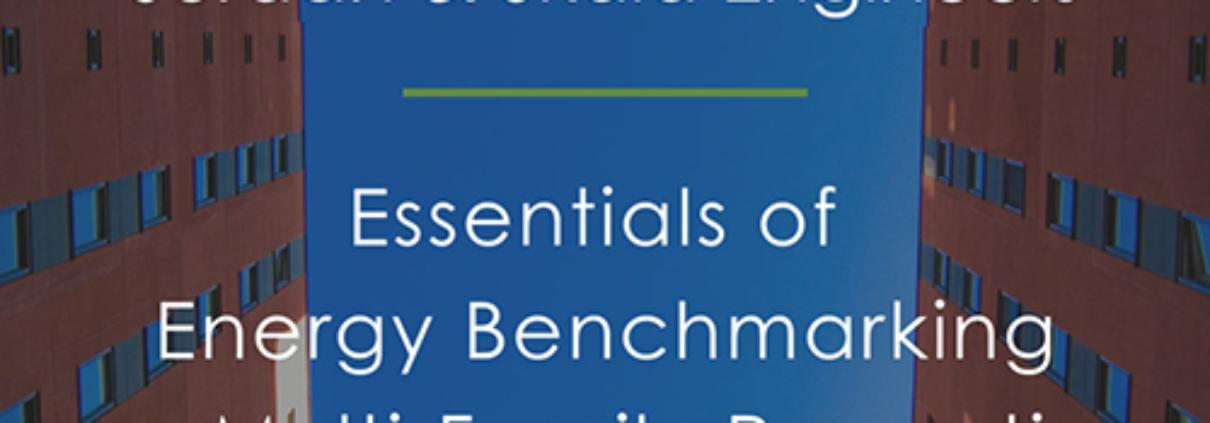
Leave a Reply
Want to join the discussion?Feel free to contribute!